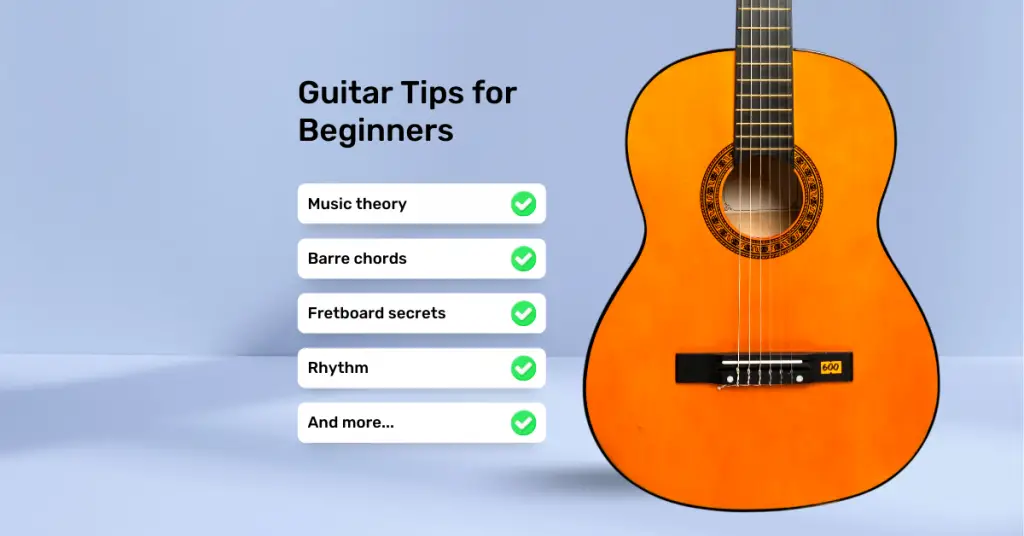Table of Contents
Understanding essential guitar scales for beginners
Are you new to scales? Or new to guitar as a whole?
Well I’m happy to see you here, where you’re going to level up your scale game!
You’re going to look at 5 essential guitar scales for beginners. These scales will give you a better understanding of notes and formulas used to make music!
What is a guitar scale?
The word scale gets thrown around a lot, and for a good reason!
Scales are building blocks in music. They give us structure for chords, arpeggios, riffs, licks, and melodies.
Here’s a more formal definition of a scale:
A scale is an organized set of intervals, and these intervals repeat at every root note. (Intervals simply define a distance from one note to another note).
When you have specified a root note for a scale, you call the scale by the name of the root note + the scale.
For example, the major scale has an interval structure of 1-2-3-4-5-6-7. You can play this on a single string by choosing a root note (starting note), and following these steps:
Whole – Whole – Half – Whole – Whole – Whole – Half
If we start from the G Note, the scale you’ll get will be called the G Major Scale.
What are the 5 essential guitar scales for beginners?
Here are the 5 scale types you’ll be looking at in this lesson.
- Minor Pentatonic
- Major Pentatonic
- Blues
- Natural Major
- Natural Minor
These scale types are common across all instruments, especially in Western music.
How to play essential guitar scales
Now we’re going to look at intervals, common shapes, and common positions for guitar scales.
The way you play and apply these scales is up to you.
I strongly suggest learning some lead guitar techniques, as they will make these scales easier to play and practice.
1. Minor Pentatonic Scales
Minor Pentatonic Scales are the bread and butter for rock guitar composition and improvisation. But fear not if you play any other style/genre, because these scales are still important and useful.
Guitar player and author Steve Khan wrote a book called Pentatonic Khancepts, it teaches all of the applications and music theory behind Pentatonic scales. It’s the best book for exploring these scales in depth.
As for you, get started by learning the common shapes shown here, then move on to learning all 5 pentatonic scale positions!
E Minor Pentatonic
Notes in E Minor Pentatonic: E-G-A-B-D
E Minor Pentatonic is arguably the most common rock/electric guitar scale of all time.
It works well in the open position and sounds especially great when played alongside an open E Minor Power Chord.
Check out this full E Minor Pentatonic scale lesson.
E Minor Pentatonic Open Position
The open position E Minor Pentatonic is great for making single note lines in the E Minor/G Major scales.
You’ll find this shape used in both rhythm and lead guitar, and it’s used in a ton of classic rock songs.

E Minor Pentatonic Shape 1
E Minor Pentatonic Shape 1 follows the same structure as the open position, but you move it up an octave higher, to the 12th fret.
This is the bread-and-butter lead guitar shape for most rock guitarists. The shape itself, when transposed, can be used in most contexts.
It’s arguably the most common 5-note scale on the guitar, with the only other competitor for first being A Minor Pentatonic.

A Minor Pentatonic Scale
Notes in A Minor Pentatonic: A-C-D-E-G
Using the same pentatonic shape you just learned, you can play the A Minor Pentatonic scale.
This is the most common way to play the scale, and you’ll start to notice it in many songs and lines as you learn more about the guitar.

2. Major Pentatonic Scales
Major pentatonic scales are just minor pentatonic scales starting from their 2nd degree. You can also look at minor pentatonic scales as major pentatonic scales starting from their 5th degree.
This means that major and minor pentatonic scales are relatives.
For this to make sense, play each of these major pentatonic scales by themselves, then play them as a second position to their relative minor. The relative minor will be shown above scale diagram, and you already learned the minor shapes in the above section!
Check out this lesson to learn more: Difference Between Major and Minor Pentatonic Scales
G Major Pentatonic Scale
Notes in G Major Pentatonic: G-A-B-D-E
Relative minor: E Minor Pentatonic

C Major Pentatonic Scale
Notes in C Major Pentatonic: C-D-E-G-A
Relative minor: A Minor Pentatonic

3. Blues Scales
The blues scale is just the minor pentatonic scale with an additional interval, the b5. You will see it highlighted in the color blue.
When using the blues note, the b5/flattened fifth, use it as a passing tone. This means you’ll use it to move as a tone that guides you to another note in the scale.
As a general rule, the blues note doesn’t sound good standing alone.
A Minor Blues Scale
Notes in A Minor Blues Scale: A-C-D-D#-E-G

E Minor Blues Scale
Notes in E Minor Blues Scale: E-G-A-B-D.

4. Major Scales
Major scales are the bread and butter for constructing Western music.
Seriously, almost every scale you can think of is derived from the major scale.
Major scales are often thought of as having a “happy sound” to them. While this is arguably true for common major chord progressions, such as a major I-IV-V, it’s not true as a whole. The musical context and notes being used are what define the overall tone and emotion of the music.
C Major
Notes in the C Major Scale: C-D-E-F-G-A-B
Relative Minor: A Minor
The C major scale is the most beginner-friendly scale, because every note in the scale is natural (they have no sharps or flats). This makes it easy to play and memorize.

G Major
Notes in the G Major Scale: G-A-B-C-D-E-F#
Relative Minor: E Minor
G Major is another beginner-friendly scale, as it only has one sharp note (F#), and the chords found in the scale are common beginner guitar chords.
You can learn more about this scale in this G Major scale lesson.

5. Minor Scales
Minor scales are relative major scales. The only difference is the note being emphasized (the tonic), and the musical context.
This is usually described using derivative and parallel scale theory. This video by guitar instructor Levi Clay explains this very well!
A Minor
Notes in the A Minor Scale: A-B-C-D-E-F-G
This is the relative minor of C Major. Once again, this makes this scale easy to play and memorize.
You can remember it as the first 7 letters of the alphabet.

E Minor
E minor is the relative minor of G Major.
Due to standard guitar tuning being largely focused around an E minor chord, this scale is very common on guitar.
Notes in the E Minor Scale: E-F#-G-A-B-C-D

Summary: Essential Guitar Scales for Beginners
There are five essential guitar scales for beginners:
- Minor Pentatonic
- Major Pentatonic
- The Blues Scale
- Natural Major
- Natural Minor
Learning these scales is your first step in understanding how scales work and is a big step towards understanding the fretboard.
Your next step is to learn how to play these scales across the fretboard! These related posts will help you.
Next steps
3 Notes Per String Major Scale (Patterns and Tabs)
How to Play Blues Scales on Guitar



